Evaluating Comments on FDA Food Labeling Rule: A Senate Report
VerifiedAdded on 2023/06/14
|7
|3627
|376
Report
AI Summary
This Senate report analyzes public comments regarding the FDA's proposed revisions to nutrition and supplement facts labels. It examines arguments both for and against the rule, focusing on perspectives from groups like the Consumers Union, Exemplar Genetics, Biotechnology Industry Organization (BIO), American Association of Bovine Practitioners (AABP), and the Department of Zoology at the University of Oxford. The report highlights concerns about the safety and environmental impact of genetically altered animals, the potential benefits of gene editing in agriculture, and the need for clear regulatory oversight. The Consumers Union advocates for rigorous safety assessments and labeling of genetically engineered foods, while Exemplar Genetics supports risk-based regulation. BIO emphasizes the importance of a clear regulatory process for maintaining industry viability. Conversely, AABP argues against strict regulation of genome-edited animals without evidence of harm, and the Department of Zoology raises concerns about off-target genetic modifications. The report ultimately informs a neutral senator on the key debates surrounding the FDA's proposed rule.
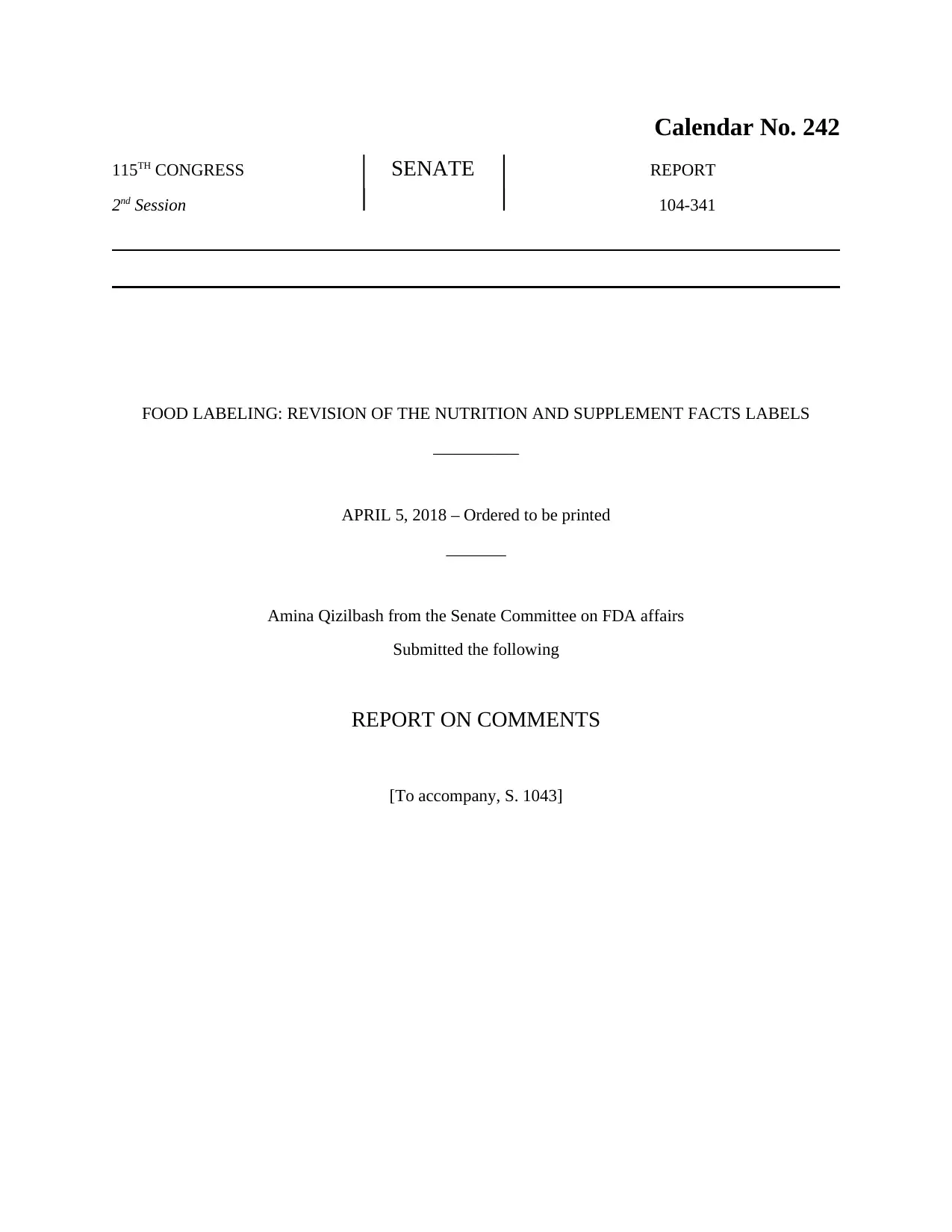
Calendar No. 242
115TH CONGRESS SENATE REPORT
2nd Session 104-341
FOOD LABELING: REVISION OF THE NUTRITION AND SUPPLEMENT FACTS LABELS
__________
APRIL 5, 2018 – Ordered to be printed
_______
Amina Qizilbash from the Senate Committee on FDA affairs
Submitted the following
REPORT ON COMMENTS
[To accompany, S. 1043]
115TH CONGRESS SENATE REPORT
2nd Session 104-341
FOOD LABELING: REVISION OF THE NUTRITION AND SUPPLEMENT FACTS LABELS
__________
APRIL 5, 2018 – Ordered to be printed
_______
Amina Qizilbash from the Senate Committee on FDA affairs
Submitted the following
REPORT ON COMMENTS
[To accompany, S. 1043]
Secure Best Marks with AI Grader
Need help grading? Try our AI Grader for instant feedback on your assignments.
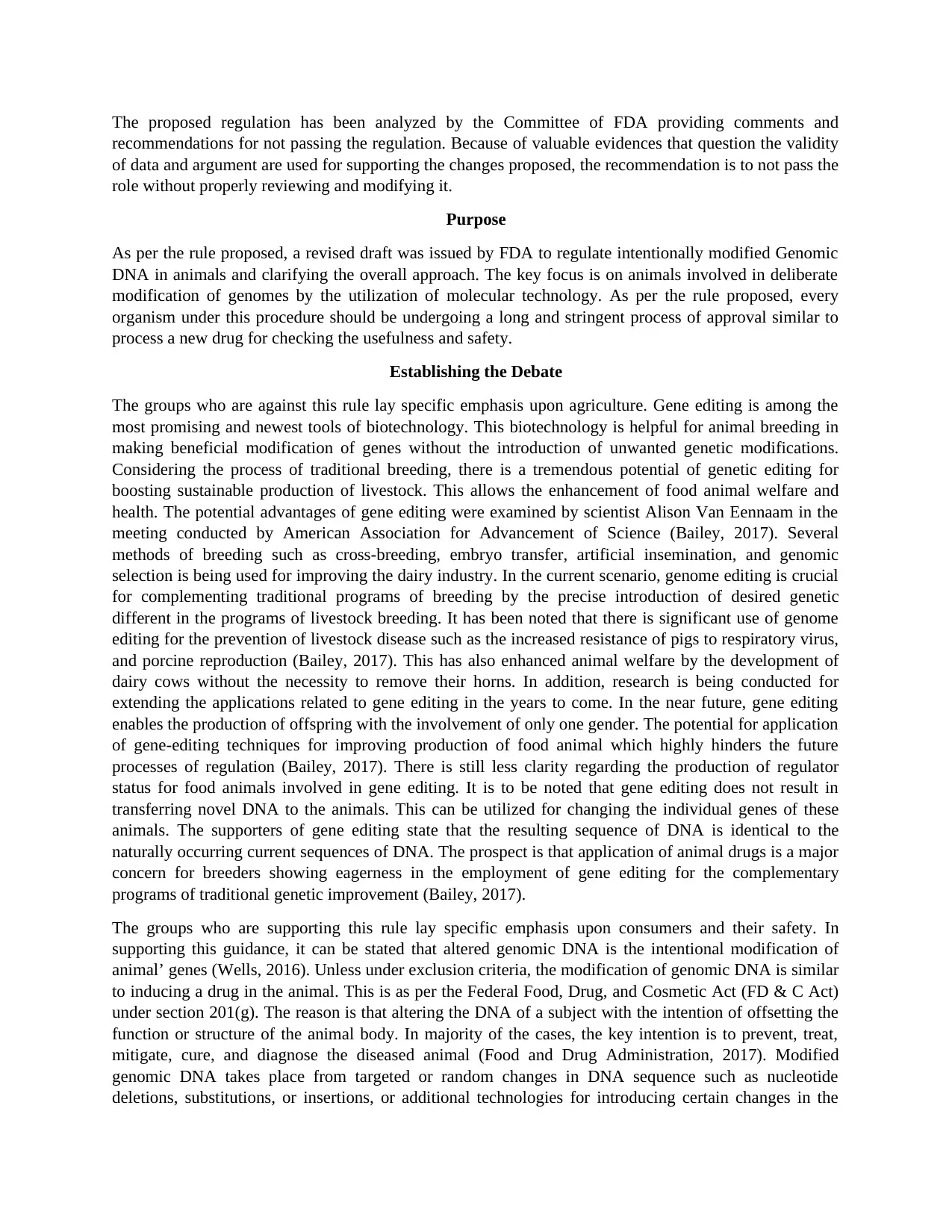
The proposed regulation has been analyzed by the Committee of FDA providing comments and
recommendations for not passing the regulation. Because of valuable evidences that question the validity
of data and argument are used for supporting the changes proposed, the recommendation is to not pass the
role without properly reviewing and modifying it.
Purpose
As per the rule proposed, a revised draft was issued by FDA to regulate intentionally modified Genomic
DNA in animals and clarifying the overall approach. The key focus is on animals involved in deliberate
modification of genomes by the utilization of molecular technology. As per the rule proposed, every
organism under this procedure should be undergoing a long and stringent process of approval similar to
process a new drug for checking the usefulness and safety.
Establishing the Debate
The groups who are against this rule lay specific emphasis upon agriculture. Gene editing is among the
most promising and newest tools of biotechnology. This biotechnology is helpful for animal breeding in
making beneficial modification of genes without the introduction of unwanted genetic modifications.
Considering the process of traditional breeding, there is a tremendous potential of genetic editing for
boosting sustainable production of livestock. This allows the enhancement of food animal welfare and
health. The potential advantages of gene editing were examined by scientist Alison Van Eennaam in the
meeting conducted by American Association for Advancement of Science (Bailey, 2017). Several
methods of breeding such as cross-breeding, embryo transfer, artificial insemination, and genomic
selection is being used for improving the dairy industry. In the current scenario, genome editing is crucial
for complementing traditional programs of breeding by the precise introduction of desired genetic
different in the programs of livestock breeding. It has been noted that there is significant use of genome
editing for the prevention of livestock disease such as the increased resistance of pigs to respiratory virus,
and porcine reproduction (Bailey, 2017). This has also enhanced animal welfare by the development of
dairy cows without the necessity to remove their horns. In addition, research is being conducted for
extending the applications related to gene editing in the years to come. In the near future, gene editing
enables the production of offspring with the involvement of only one gender. The potential for application
of gene-editing techniques for improving production of food animal which highly hinders the future
processes of regulation (Bailey, 2017). There is still less clarity regarding the production of regulator
status for food animals involved in gene editing. It is to be noted that gene editing does not result in
transferring novel DNA to the animals. This can be utilized for changing the individual genes of these
animals. The supporters of gene editing state that the resulting sequence of DNA is identical to the
naturally occurring current sequences of DNA. The prospect is that application of animal drugs is a major
concern for breeders showing eagerness in the employment of gene editing for the complementary
programs of traditional genetic improvement (Bailey, 2017).
The groups who are supporting this rule lay specific emphasis upon consumers and their safety. In
supporting this guidance, it can be stated that altered genomic DNA is the intentional modification of
animal’ genes (Wells, 2016). Unless under exclusion criteria, the modification of genomic DNA is similar
to inducing a drug in the animal. This is as per the Federal Food, Drug, and Cosmetic Act (FD & C Act)
under section 201(g). The reason is that altering the DNA of a subject with the intention of offsetting the
function or structure of the animal body. In majority of the cases, the key intention is to prevent, treat,
mitigate, cure, and diagnose the diseased animal (Food and Drug Administration, 2017). Modified
genomic DNA takes place from targeted or random changes in DNA sequence such as nucleotide
deletions, substitutions, or insertions, or additional technologies for introducing certain changes in the
recommendations for not passing the regulation. Because of valuable evidences that question the validity
of data and argument are used for supporting the changes proposed, the recommendation is to not pass the
role without properly reviewing and modifying it.
Purpose
As per the rule proposed, a revised draft was issued by FDA to regulate intentionally modified Genomic
DNA in animals and clarifying the overall approach. The key focus is on animals involved in deliberate
modification of genomes by the utilization of molecular technology. As per the rule proposed, every
organism under this procedure should be undergoing a long and stringent process of approval similar to
process a new drug for checking the usefulness and safety.
Establishing the Debate
The groups who are against this rule lay specific emphasis upon agriculture. Gene editing is among the
most promising and newest tools of biotechnology. This biotechnology is helpful for animal breeding in
making beneficial modification of genes without the introduction of unwanted genetic modifications.
Considering the process of traditional breeding, there is a tremendous potential of genetic editing for
boosting sustainable production of livestock. This allows the enhancement of food animal welfare and
health. The potential advantages of gene editing were examined by scientist Alison Van Eennaam in the
meeting conducted by American Association for Advancement of Science (Bailey, 2017). Several
methods of breeding such as cross-breeding, embryo transfer, artificial insemination, and genomic
selection is being used for improving the dairy industry. In the current scenario, genome editing is crucial
for complementing traditional programs of breeding by the precise introduction of desired genetic
different in the programs of livestock breeding. It has been noted that there is significant use of genome
editing for the prevention of livestock disease such as the increased resistance of pigs to respiratory virus,
and porcine reproduction (Bailey, 2017). This has also enhanced animal welfare by the development of
dairy cows without the necessity to remove their horns. In addition, research is being conducted for
extending the applications related to gene editing in the years to come. In the near future, gene editing
enables the production of offspring with the involvement of only one gender. The potential for application
of gene-editing techniques for improving production of food animal which highly hinders the future
processes of regulation (Bailey, 2017). There is still less clarity regarding the production of regulator
status for food animals involved in gene editing. It is to be noted that gene editing does not result in
transferring novel DNA to the animals. This can be utilized for changing the individual genes of these
animals. The supporters of gene editing state that the resulting sequence of DNA is identical to the
naturally occurring current sequences of DNA. The prospect is that application of animal drugs is a major
concern for breeders showing eagerness in the employment of gene editing for the complementary
programs of traditional genetic improvement (Bailey, 2017).
The groups who are supporting this rule lay specific emphasis upon consumers and their safety. In
supporting this guidance, it can be stated that altered genomic DNA is the intentional modification of
animal’ genes (Wells, 2016). Unless under exclusion criteria, the modification of genomic DNA is similar
to inducing a drug in the animal. This is as per the Federal Food, Drug, and Cosmetic Act (FD & C Act)
under section 201(g). The reason is that altering the DNA of a subject with the intention of offsetting the
function or structure of the animal body. In majority of the cases, the key intention is to prevent, treat,
mitigate, cure, and diagnose the diseased animal (Food and Drug Administration, 2017). Modified
genomic DNA takes place from targeted or random changes in DNA sequence such as nucleotide
deletions, substitutions, or insertions, or additional technologies for introducing certain changes in the
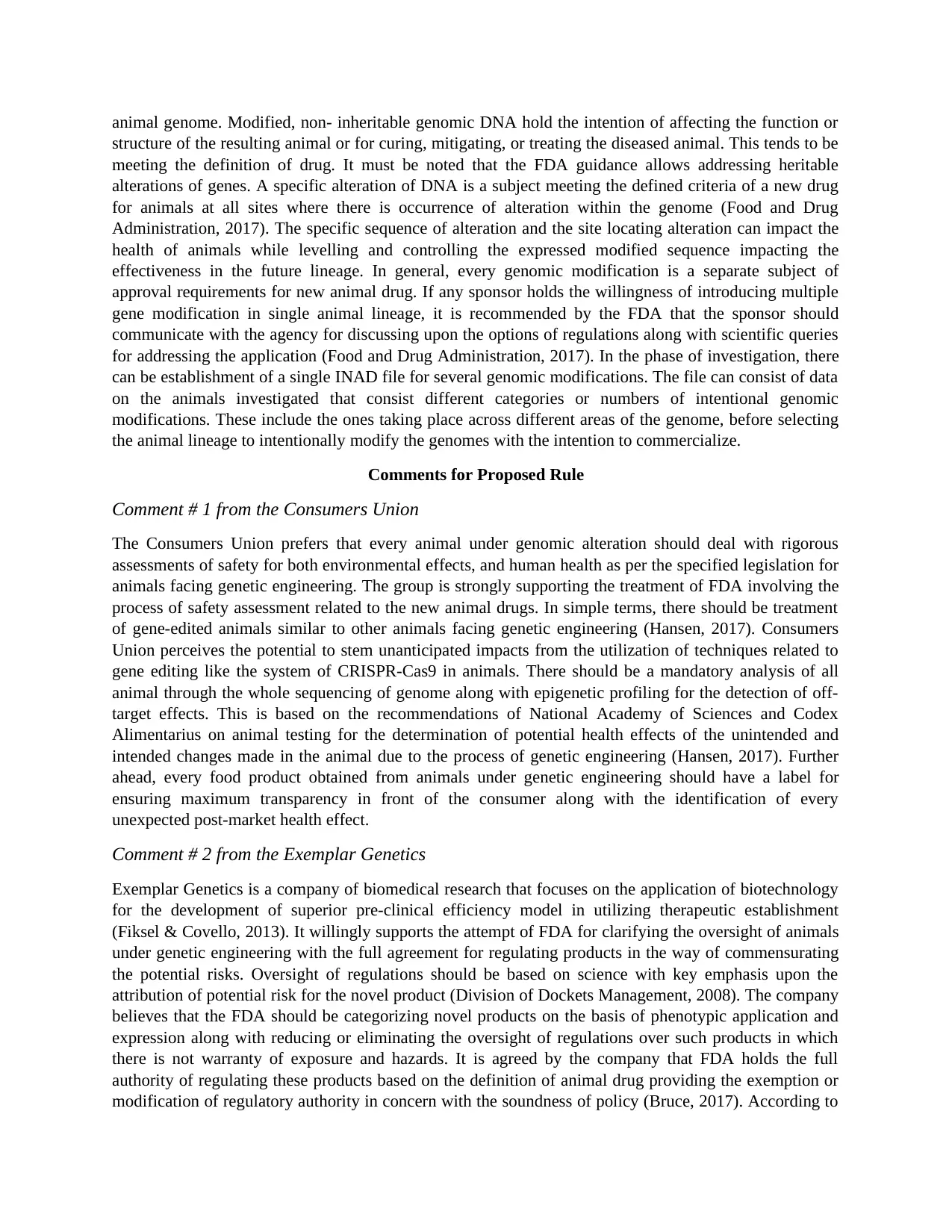
animal genome. Modified, non- inheritable genomic DNA hold the intention of affecting the function or
structure of the resulting animal or for curing, mitigating, or treating the diseased animal. This tends to be
meeting the definition of drug. It must be noted that the FDA guidance allows addressing heritable
alterations of genes. A specific alteration of DNA is a subject meeting the defined criteria of a new drug
for animals at all sites where there is occurrence of alteration within the genome (Food and Drug
Administration, 2017). The specific sequence of alteration and the site locating alteration can impact the
health of animals while levelling and controlling the expressed modified sequence impacting the
effectiveness in the future lineage. In general, every genomic modification is a separate subject of
approval requirements for new animal drug. If any sponsor holds the willingness of introducing multiple
gene modification in single animal lineage, it is recommended by the FDA that the sponsor should
communicate with the agency for discussing upon the options of regulations along with scientific queries
for addressing the application (Food and Drug Administration, 2017). In the phase of investigation, there
can be establishment of a single INAD file for several genomic modifications. The file can consist of data
on the animals investigated that consist different categories or numbers of intentional genomic
modifications. These include the ones taking place across different areas of the genome, before selecting
the animal lineage to intentionally modify the genomes with the intention to commercialize.
Comments for Proposed Rule
Comment # 1 from the Consumers Union
The Consumers Union prefers that every animal under genomic alteration should deal with rigorous
assessments of safety for both environmental effects, and human health as per the specified legislation for
animals facing genetic engineering. The group is strongly supporting the treatment of FDA involving the
process of safety assessment related to the new animal drugs. In simple terms, there should be treatment
of gene-edited animals similar to other animals facing genetic engineering (Hansen, 2017). Consumers
Union perceives the potential to stem unanticipated impacts from the utilization of techniques related to
gene editing like the system of CRISPR-Cas9 in animals. There should be a mandatory analysis of all
animal through the whole sequencing of genome along with epigenetic profiling for the detection of off-
target effects. This is based on the recommendations of National Academy of Sciences and Codex
Alimentarius on animal testing for the determination of potential health effects of the unintended and
intended changes made in the animal due to the process of genetic engineering (Hansen, 2017). Further
ahead, every food product obtained from animals under genetic engineering should have a label for
ensuring maximum transparency in front of the consumer along with the identification of every
unexpected post-market health effect.
Comment # 2 from the Exemplar Genetics
Exemplar Genetics is a company of biomedical research that focuses on the application of biotechnology
for the development of superior pre-clinical efficiency model in utilizing therapeutic establishment
(Fiksel & Covello, 2013). It willingly supports the attempt of FDA for clarifying the oversight of animals
under genetic engineering with the full agreement for regulating products in the way of commensurating
the potential risks. Oversight of regulations should be based on science with key emphasis upon the
attribution of potential risk for the novel product (Division of Dockets Management, 2008). The company
believes that the FDA should be categorizing novel products on the basis of phenotypic application and
expression along with reducing or eliminating the oversight of regulations over such products in which
there is not warranty of exposure and hazards. It is agreed by the company that FDA holds the full
authority of regulating these products based on the definition of animal drug providing the exemption or
modification of regulatory authority in concern with the soundness of policy (Bruce, 2017). According to
structure of the resulting animal or for curing, mitigating, or treating the diseased animal. This tends to be
meeting the definition of drug. It must be noted that the FDA guidance allows addressing heritable
alterations of genes. A specific alteration of DNA is a subject meeting the defined criteria of a new drug
for animals at all sites where there is occurrence of alteration within the genome (Food and Drug
Administration, 2017). The specific sequence of alteration and the site locating alteration can impact the
health of animals while levelling and controlling the expressed modified sequence impacting the
effectiveness in the future lineage. In general, every genomic modification is a separate subject of
approval requirements for new animal drug. If any sponsor holds the willingness of introducing multiple
gene modification in single animal lineage, it is recommended by the FDA that the sponsor should
communicate with the agency for discussing upon the options of regulations along with scientific queries
for addressing the application (Food and Drug Administration, 2017). In the phase of investigation, there
can be establishment of a single INAD file for several genomic modifications. The file can consist of data
on the animals investigated that consist different categories or numbers of intentional genomic
modifications. These include the ones taking place across different areas of the genome, before selecting
the animal lineage to intentionally modify the genomes with the intention to commercialize.
Comments for Proposed Rule
Comment # 1 from the Consumers Union
The Consumers Union prefers that every animal under genomic alteration should deal with rigorous
assessments of safety for both environmental effects, and human health as per the specified legislation for
animals facing genetic engineering. The group is strongly supporting the treatment of FDA involving the
process of safety assessment related to the new animal drugs. In simple terms, there should be treatment
of gene-edited animals similar to other animals facing genetic engineering (Hansen, 2017). Consumers
Union perceives the potential to stem unanticipated impacts from the utilization of techniques related to
gene editing like the system of CRISPR-Cas9 in animals. There should be a mandatory analysis of all
animal through the whole sequencing of genome along with epigenetic profiling for the detection of off-
target effects. This is based on the recommendations of National Academy of Sciences and Codex
Alimentarius on animal testing for the determination of potential health effects of the unintended and
intended changes made in the animal due to the process of genetic engineering (Hansen, 2017). Further
ahead, every food product obtained from animals under genetic engineering should have a label for
ensuring maximum transparency in front of the consumer along with the identification of every
unexpected post-market health effect.
Comment # 2 from the Exemplar Genetics
Exemplar Genetics is a company of biomedical research that focuses on the application of biotechnology
for the development of superior pre-clinical efficiency model in utilizing therapeutic establishment
(Fiksel & Covello, 2013). It willingly supports the attempt of FDA for clarifying the oversight of animals
under genetic engineering with the full agreement for regulating products in the way of commensurating
the potential risks. Oversight of regulations should be based on science with key emphasis upon the
attribution of potential risk for the novel product (Division of Dockets Management, 2008). The company
believes that the FDA should be categorizing novel products on the basis of phenotypic application and
expression along with reducing or eliminating the oversight of regulations over such products in which
there is not warranty of exposure and hazards. It is agreed by the company that FDA holds the full
authority of regulating these products based on the definition of animal drug providing the exemption or
modification of regulatory authority in concern with the soundness of policy (Bruce, 2017). According to
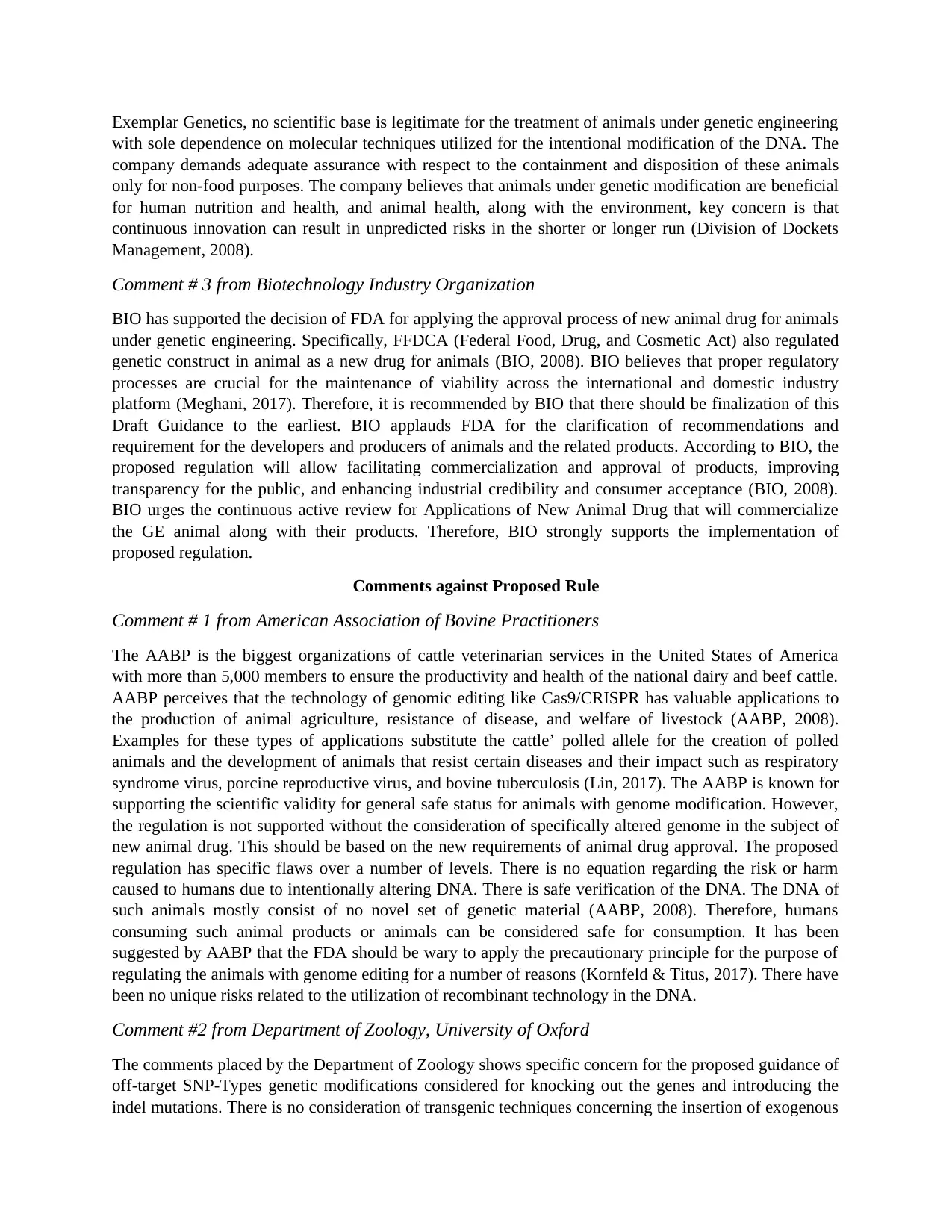
Exemplar Genetics, no scientific base is legitimate for the treatment of animals under genetic engineering
with sole dependence on molecular techniques utilized for the intentional modification of the DNA. The
company demands adequate assurance with respect to the containment and disposition of these animals
only for non-food purposes. The company believes that animals under genetic modification are beneficial
for human nutrition and health, and animal health, along with the environment, key concern is that
continuous innovation can result in unpredicted risks in the shorter or longer run (Division of Dockets
Management, 2008).
Comment # 3 from Biotechnology Industry Organization
BIO has supported the decision of FDA for applying the approval process of new animal drug for animals
under genetic engineering. Specifically, FFDCA (Federal Food, Drug, and Cosmetic Act) also regulated
genetic construct in animal as a new drug for animals (BIO, 2008). BIO believes that proper regulatory
processes are crucial for the maintenance of viability across the international and domestic industry
platform (Meghani, 2017). Therefore, it is recommended by BIO that there should be finalization of this
Draft Guidance to the earliest. BIO applauds FDA for the clarification of recommendations and
requirement for the developers and producers of animals and the related products. According to BIO, the
proposed regulation will allow facilitating commercialization and approval of products, improving
transparency for the public, and enhancing industrial credibility and consumer acceptance (BIO, 2008).
BIO urges the continuous active review for Applications of New Animal Drug that will commercialize
the GE animal along with their products. Therefore, BIO strongly supports the implementation of
proposed regulation.
Comments against Proposed Rule
Comment # 1 from American Association of Bovine Practitioners
The AABP is the biggest organizations of cattle veterinarian services in the United States of America
with more than 5,000 members to ensure the productivity and health of the national dairy and beef cattle.
AABP perceives that the technology of genomic editing like Cas9/CRISPR has valuable applications to
the production of animal agriculture, resistance of disease, and welfare of livestock (AABP, 2008).
Examples for these types of applications substitute the cattle’ polled allele for the creation of polled
animals and the development of animals that resist certain diseases and their impact such as respiratory
syndrome virus, porcine reproductive virus, and bovine tuberculosis (Lin, 2017). The AABP is known for
supporting the scientific validity for general safe status for animals with genome modification. However,
the regulation is not supported without the consideration of specifically altered genome in the subject of
new animal drug. This should be based on the new requirements of animal drug approval. The proposed
regulation has specific flaws over a number of levels. There is no equation regarding the risk or harm
caused to humans due to intentionally altering DNA. There is safe verification of the DNA. The DNA of
such animals mostly consist of no novel set of genetic material (AABP, 2008). Therefore, humans
consuming such animal products or animals can be considered safe for consumption. It has been
suggested by AABP that the FDA should be wary to apply the precautionary principle for the purpose of
regulating the animals with genome editing for a number of reasons (Kornfeld & Titus, 2017). There have
been no unique risks related to the utilization of recombinant technology in the DNA.
Comment #2 from Department of Zoology, University of Oxford
The comments placed by the Department of Zoology shows specific concern for the proposed guidance of
off-target SNP-Types genetic modifications considered for knocking out the genes and introducing the
indel mutations. There is no consideration of transgenic techniques concerning the insertion of exogenous
with sole dependence on molecular techniques utilized for the intentional modification of the DNA. The
company demands adequate assurance with respect to the containment and disposition of these animals
only for non-food purposes. The company believes that animals under genetic modification are beneficial
for human nutrition and health, and animal health, along with the environment, key concern is that
continuous innovation can result in unpredicted risks in the shorter or longer run (Division of Dockets
Management, 2008).
Comment # 3 from Biotechnology Industry Organization
BIO has supported the decision of FDA for applying the approval process of new animal drug for animals
under genetic engineering. Specifically, FFDCA (Federal Food, Drug, and Cosmetic Act) also regulated
genetic construct in animal as a new drug for animals (BIO, 2008). BIO believes that proper regulatory
processes are crucial for the maintenance of viability across the international and domestic industry
platform (Meghani, 2017). Therefore, it is recommended by BIO that there should be finalization of this
Draft Guidance to the earliest. BIO applauds FDA for the clarification of recommendations and
requirement for the developers and producers of animals and the related products. According to BIO, the
proposed regulation will allow facilitating commercialization and approval of products, improving
transparency for the public, and enhancing industrial credibility and consumer acceptance (BIO, 2008).
BIO urges the continuous active review for Applications of New Animal Drug that will commercialize
the GE animal along with their products. Therefore, BIO strongly supports the implementation of
proposed regulation.
Comments against Proposed Rule
Comment # 1 from American Association of Bovine Practitioners
The AABP is the biggest organizations of cattle veterinarian services in the United States of America
with more than 5,000 members to ensure the productivity and health of the national dairy and beef cattle.
AABP perceives that the technology of genomic editing like Cas9/CRISPR has valuable applications to
the production of animal agriculture, resistance of disease, and welfare of livestock (AABP, 2008).
Examples for these types of applications substitute the cattle’ polled allele for the creation of polled
animals and the development of animals that resist certain diseases and their impact such as respiratory
syndrome virus, porcine reproductive virus, and bovine tuberculosis (Lin, 2017). The AABP is known for
supporting the scientific validity for general safe status for animals with genome modification. However,
the regulation is not supported without the consideration of specifically altered genome in the subject of
new animal drug. This should be based on the new requirements of animal drug approval. The proposed
regulation has specific flaws over a number of levels. There is no equation regarding the risk or harm
caused to humans due to intentionally altering DNA. There is safe verification of the DNA. The DNA of
such animals mostly consist of no novel set of genetic material (AABP, 2008). Therefore, humans
consuming such animal products or animals can be considered safe for consumption. It has been
suggested by AABP that the FDA should be wary to apply the precautionary principle for the purpose of
regulating the animals with genome editing for a number of reasons (Kornfeld & Titus, 2017). There have
been no unique risks related to the utilization of recombinant technology in the DNA.
Comment #2 from Department of Zoology, University of Oxford
The comments placed by the Department of Zoology shows specific concern for the proposed guidance of
off-target SNP-Types genetic modifications considered for knocking out the genes and introducing the
indel mutations. There is no consideration of transgenic techniques concerning the insertion of exogenous
Secure Best Marks with AI Grader
Need help grading? Try our AI Grader for instant feedback on your assignments.
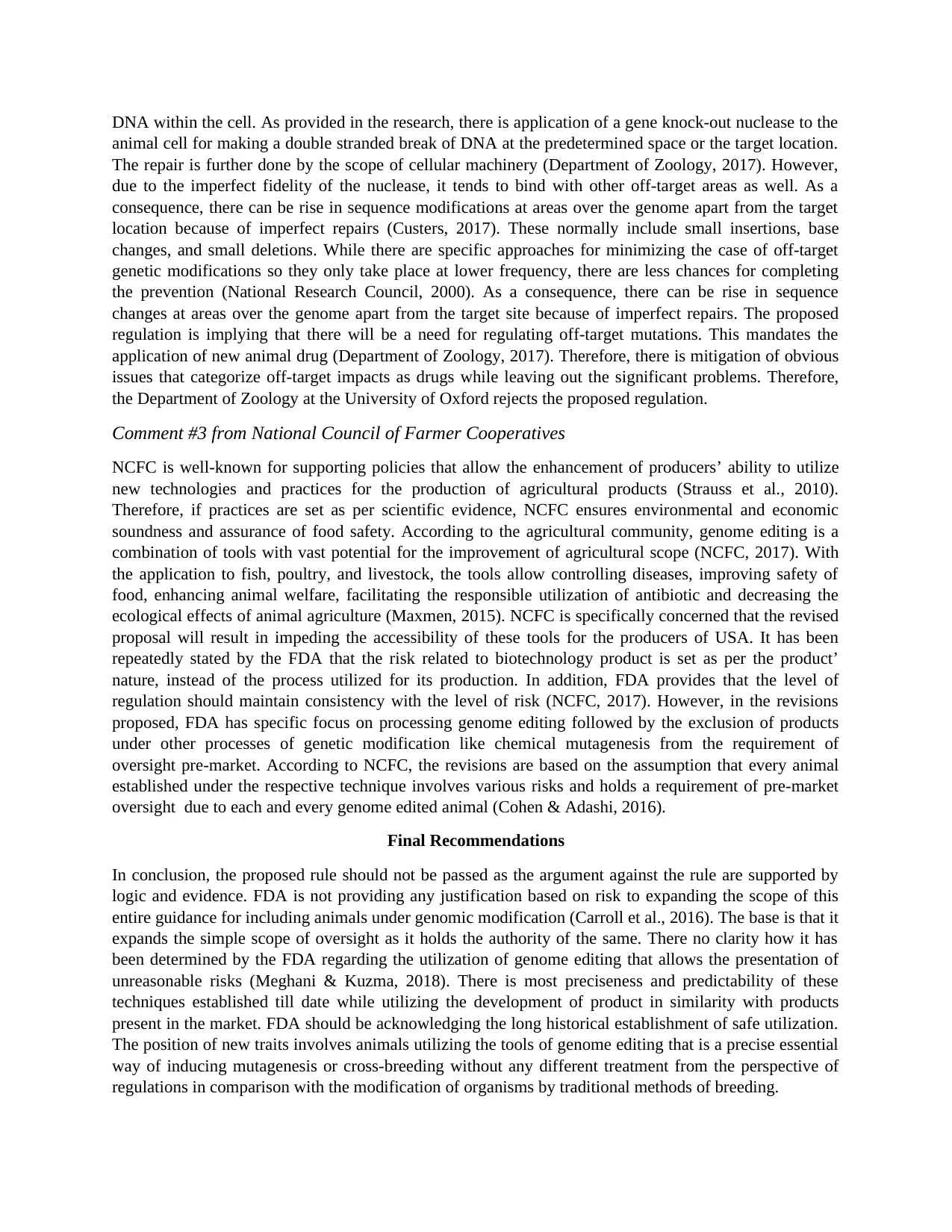
DNA within the cell. As provided in the research, there is application of a gene knock-out nuclease to the
animal cell for making a double stranded break of DNA at the predetermined space or the target location.
The repair is further done by the scope of cellular machinery (Department of Zoology, 2017). However,
due to the imperfect fidelity of the nuclease, it tends to bind with other off-target areas as well. As a
consequence, there can be rise in sequence modifications at areas over the genome apart from the target
location because of imperfect repairs (Custers, 2017). These normally include small insertions, base
changes, and small deletions. While there are specific approaches for minimizing the case of off-target
genetic modifications so they only take place at lower frequency, there are less chances for completing
the prevention (National Research Council, 2000). As a consequence, there can be rise in sequence
changes at areas over the genome apart from the target site because of imperfect repairs. The proposed
regulation is implying that there will be a need for regulating off-target mutations. This mandates the
application of new animal drug (Department of Zoology, 2017). Therefore, there is mitigation of obvious
issues that categorize off-target impacts as drugs while leaving out the significant problems. Therefore,
the Department of Zoology at the University of Oxford rejects the proposed regulation.
Comment #3 from National Council of Farmer Cooperatives
NCFC is well-known for supporting policies that allow the enhancement of producers’ ability to utilize
new technologies and practices for the production of agricultural products (Strauss et al., 2010).
Therefore, if practices are set as per scientific evidence, NCFC ensures environmental and economic
soundness and assurance of food safety. According to the agricultural community, genome editing is a
combination of tools with vast potential for the improvement of agricultural scope (NCFC, 2017). With
the application to fish, poultry, and livestock, the tools allow controlling diseases, improving safety of
food, enhancing animal welfare, facilitating the responsible utilization of antibiotic and decreasing the
ecological effects of animal agriculture (Maxmen, 2015). NCFC is specifically concerned that the revised
proposal will result in impeding the accessibility of these tools for the producers of USA. It has been
repeatedly stated by the FDA that the risk related to biotechnology product is set as per the product’
nature, instead of the process utilized for its production. In addition, FDA provides that the level of
regulation should maintain consistency with the level of risk (NCFC, 2017). However, in the revisions
proposed, FDA has specific focus on processing genome editing followed by the exclusion of products
under other processes of genetic modification like chemical mutagenesis from the requirement of
oversight pre-market. According to NCFC, the revisions are based on the assumption that every animal
established under the respective technique involves various risks and holds a requirement of pre-market
oversight due to each and every genome edited animal (Cohen & Adashi, 2016).
Final Recommendations
In conclusion, the proposed rule should not be passed as the argument against the rule are supported by
logic and evidence. FDA is not providing any justification based on risk to expanding the scope of this
entire guidance for including animals under genomic modification (Carroll et al., 2016). The base is that it
expands the simple scope of oversight as it holds the authority of the same. There no clarity how it has
been determined by the FDA regarding the utilization of genome editing that allows the presentation of
unreasonable risks (Meghani & Kuzma, 2018). There is most preciseness and predictability of these
techniques established till date while utilizing the development of product in similarity with products
present in the market. FDA should be acknowledging the long historical establishment of safe utilization.
The position of new traits involves animals utilizing the tools of genome editing that is a precise essential
way of inducing mutagenesis or cross-breeding without any different treatment from the perspective of
regulations in comparison with the modification of organisms by traditional methods of breeding.
animal cell for making a double stranded break of DNA at the predetermined space or the target location.
The repair is further done by the scope of cellular machinery (Department of Zoology, 2017). However,
due to the imperfect fidelity of the nuclease, it tends to bind with other off-target areas as well. As a
consequence, there can be rise in sequence modifications at areas over the genome apart from the target
location because of imperfect repairs (Custers, 2017). These normally include small insertions, base
changes, and small deletions. While there are specific approaches for minimizing the case of off-target
genetic modifications so they only take place at lower frequency, there are less chances for completing
the prevention (National Research Council, 2000). As a consequence, there can be rise in sequence
changes at areas over the genome apart from the target site because of imperfect repairs. The proposed
regulation is implying that there will be a need for regulating off-target mutations. This mandates the
application of new animal drug (Department of Zoology, 2017). Therefore, there is mitigation of obvious
issues that categorize off-target impacts as drugs while leaving out the significant problems. Therefore,
the Department of Zoology at the University of Oxford rejects the proposed regulation.
Comment #3 from National Council of Farmer Cooperatives
NCFC is well-known for supporting policies that allow the enhancement of producers’ ability to utilize
new technologies and practices for the production of agricultural products (Strauss et al., 2010).
Therefore, if practices are set as per scientific evidence, NCFC ensures environmental and economic
soundness and assurance of food safety. According to the agricultural community, genome editing is a
combination of tools with vast potential for the improvement of agricultural scope (NCFC, 2017). With
the application to fish, poultry, and livestock, the tools allow controlling diseases, improving safety of
food, enhancing animal welfare, facilitating the responsible utilization of antibiotic and decreasing the
ecological effects of animal agriculture (Maxmen, 2015). NCFC is specifically concerned that the revised
proposal will result in impeding the accessibility of these tools for the producers of USA. It has been
repeatedly stated by the FDA that the risk related to biotechnology product is set as per the product’
nature, instead of the process utilized for its production. In addition, FDA provides that the level of
regulation should maintain consistency with the level of risk (NCFC, 2017). However, in the revisions
proposed, FDA has specific focus on processing genome editing followed by the exclusion of products
under other processes of genetic modification like chemical mutagenesis from the requirement of
oversight pre-market. According to NCFC, the revisions are based on the assumption that every animal
established under the respective technique involves various risks and holds a requirement of pre-market
oversight due to each and every genome edited animal (Cohen & Adashi, 2016).
Final Recommendations
In conclusion, the proposed rule should not be passed as the argument against the rule are supported by
logic and evidence. FDA is not providing any justification based on risk to expanding the scope of this
entire guidance for including animals under genomic modification (Carroll et al., 2016). The base is that it
expands the simple scope of oversight as it holds the authority of the same. There no clarity how it has
been determined by the FDA regarding the utilization of genome editing that allows the presentation of
unreasonable risks (Meghani & Kuzma, 2018). There is most preciseness and predictability of these
techniques established till date while utilizing the development of product in similarity with products
present in the market. FDA should be acknowledging the long historical establishment of safe utilization.
The position of new traits involves animals utilizing the tools of genome editing that is a precise essential
way of inducing mutagenesis or cross-breeding without any different treatment from the perspective of
regulations in comparison with the modification of organisms by traditional methods of breeding.
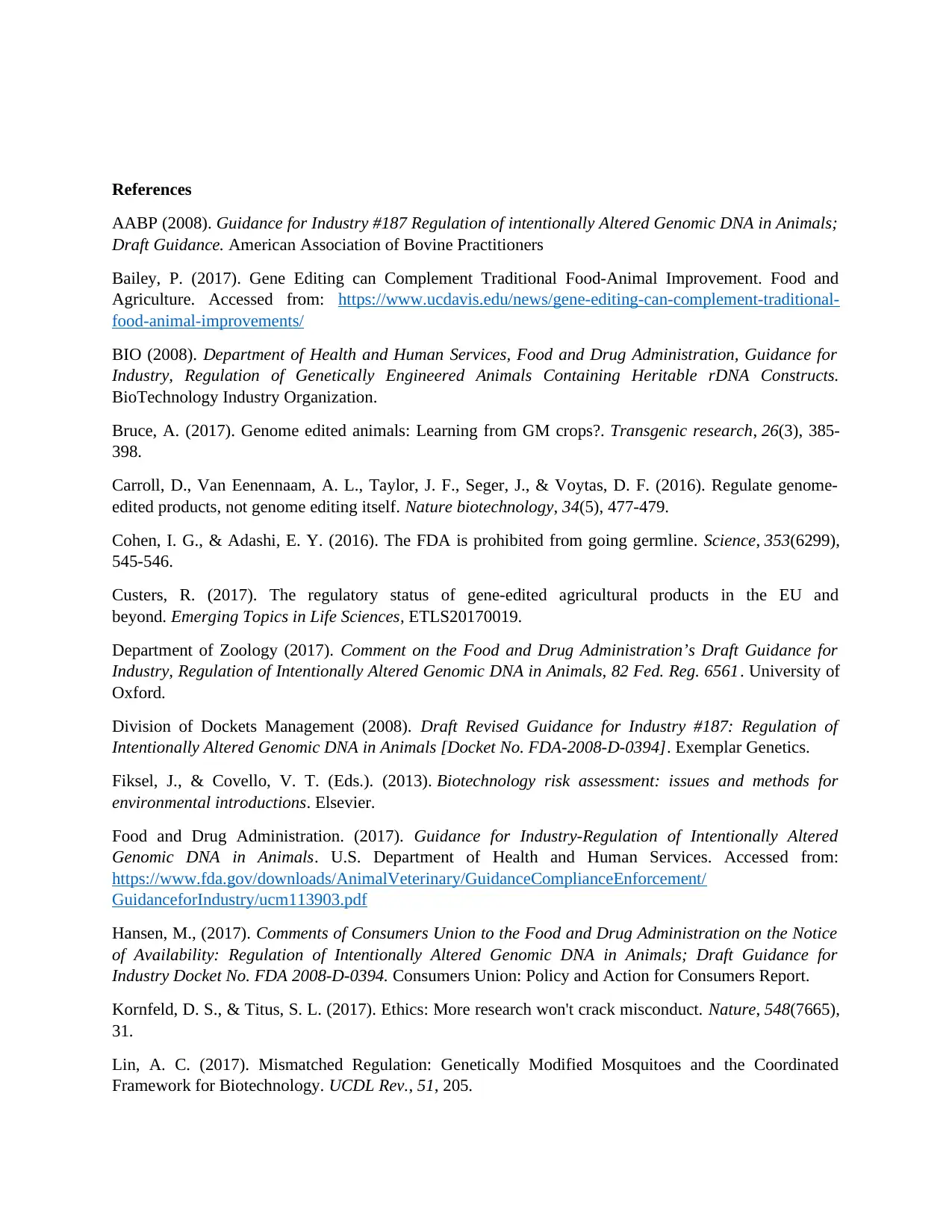
References
AABP (2008). Guidance for Industry #187 Regulation of intentionally Altered Genomic DNA in Animals;
Draft Guidance. American Association of Bovine Practitioners
Bailey, P. (2017). Gene Editing can Complement Traditional Food-Animal Improvement. Food and
Agriculture. Accessed from: https://www.ucdavis.edu/news/gene-editing-can-complement-traditional-
food-animal-improvements/
BIO (2008). Department of Health and Human Services, Food and Drug Administration, Guidance for
Industry, Regulation of Genetically Engineered Animals Containing Heritable rDNA Constructs.
BioTechnology Industry Organization.
Bruce, A. (2017). Genome edited animals: Learning from GM crops?. Transgenic research, 26(3), 385-
398.
Carroll, D., Van Eenennaam, A. L., Taylor, J. F., Seger, J., & Voytas, D. F. (2016). Regulate genome-
edited products, not genome editing itself. Nature biotechnology, 34(5), 477-479.
Cohen, I. G., & Adashi, E. Y. (2016). The FDA is prohibited from going germline. Science, 353(6299),
545-546.
Custers, R. (2017). The regulatory status of gene-edited agricultural products in the EU and
beyond. Emerging Topics in Life Sciences, ETLS20170019.
Department of Zoology (2017). Comment on the Food and Drug Administration’s Draft Guidance for
Industry, Regulation of Intentionally Altered Genomic DNA in Animals, 82 Fed. Reg. 6561. University of
Oxford.
Division of Dockets Management (2008). Draft Revised Guidance for Industry #187: Regulation of
Intentionally Altered Genomic DNA in Animals [Docket No. FDA-2008-D-0394]. Exemplar Genetics.
Fiksel, J., & Covello, V. T. (Eds.). (2013). Biotechnology risk assessment: issues and methods for
environmental introductions. Elsevier.
Food and Drug Administration. (2017). Guidance for Industry-Regulation of Intentionally Altered
Genomic DNA in Animals. U.S. Department of Health and Human Services. Accessed from:
https://www.fda.gov/downloads/AnimalVeterinary/GuidanceComplianceEnforcement/
GuidanceforIndustry/ucm113903.pdf
Hansen, M., (2017). Comments of Consumers Union to the Food and Drug Administration on the Notice
of Availability: Regulation of Intentionally Altered Genomic DNA in Animals; Draft Guidance for
Industry Docket No. FDA 2008-D-0394. Consumers Union: Policy and Action for Consumers Report.
Kornfeld, D. S., & Titus, S. L. (2017). Ethics: More research won't crack misconduct. Nature, 548(7665),
31.
Lin, A. C. (2017). Mismatched Regulation: Genetically Modified Mosquitoes and the Coordinated
Framework for Biotechnology. UCDL Rev., 51, 205.
AABP (2008). Guidance for Industry #187 Regulation of intentionally Altered Genomic DNA in Animals;
Draft Guidance. American Association of Bovine Practitioners
Bailey, P. (2017). Gene Editing can Complement Traditional Food-Animal Improvement. Food and
Agriculture. Accessed from: https://www.ucdavis.edu/news/gene-editing-can-complement-traditional-
food-animal-improvements/
BIO (2008). Department of Health and Human Services, Food and Drug Administration, Guidance for
Industry, Regulation of Genetically Engineered Animals Containing Heritable rDNA Constructs.
BioTechnology Industry Organization.
Bruce, A. (2017). Genome edited animals: Learning from GM crops?. Transgenic research, 26(3), 385-
398.
Carroll, D., Van Eenennaam, A. L., Taylor, J. F., Seger, J., & Voytas, D. F. (2016). Regulate genome-
edited products, not genome editing itself. Nature biotechnology, 34(5), 477-479.
Cohen, I. G., & Adashi, E. Y. (2016). The FDA is prohibited from going germline. Science, 353(6299),
545-546.
Custers, R. (2017). The regulatory status of gene-edited agricultural products in the EU and
beyond. Emerging Topics in Life Sciences, ETLS20170019.
Department of Zoology (2017). Comment on the Food and Drug Administration’s Draft Guidance for
Industry, Regulation of Intentionally Altered Genomic DNA in Animals, 82 Fed. Reg. 6561. University of
Oxford.
Division of Dockets Management (2008). Draft Revised Guidance for Industry #187: Regulation of
Intentionally Altered Genomic DNA in Animals [Docket No. FDA-2008-D-0394]. Exemplar Genetics.
Fiksel, J., & Covello, V. T. (Eds.). (2013). Biotechnology risk assessment: issues and methods for
environmental introductions. Elsevier.
Food and Drug Administration. (2017). Guidance for Industry-Regulation of Intentionally Altered
Genomic DNA in Animals. U.S. Department of Health and Human Services. Accessed from:
https://www.fda.gov/downloads/AnimalVeterinary/GuidanceComplianceEnforcement/
GuidanceforIndustry/ucm113903.pdf
Hansen, M., (2017). Comments of Consumers Union to the Food and Drug Administration on the Notice
of Availability: Regulation of Intentionally Altered Genomic DNA in Animals; Draft Guidance for
Industry Docket No. FDA 2008-D-0394. Consumers Union: Policy and Action for Consumers Report.
Kornfeld, D. S., & Titus, S. L. (2017). Ethics: More research won't crack misconduct. Nature, 548(7665),
31.
Lin, A. C. (2017). Mismatched Regulation: Genetically Modified Mosquitoes and the Coordinated
Framework for Biotechnology. UCDL Rev., 51, 205.
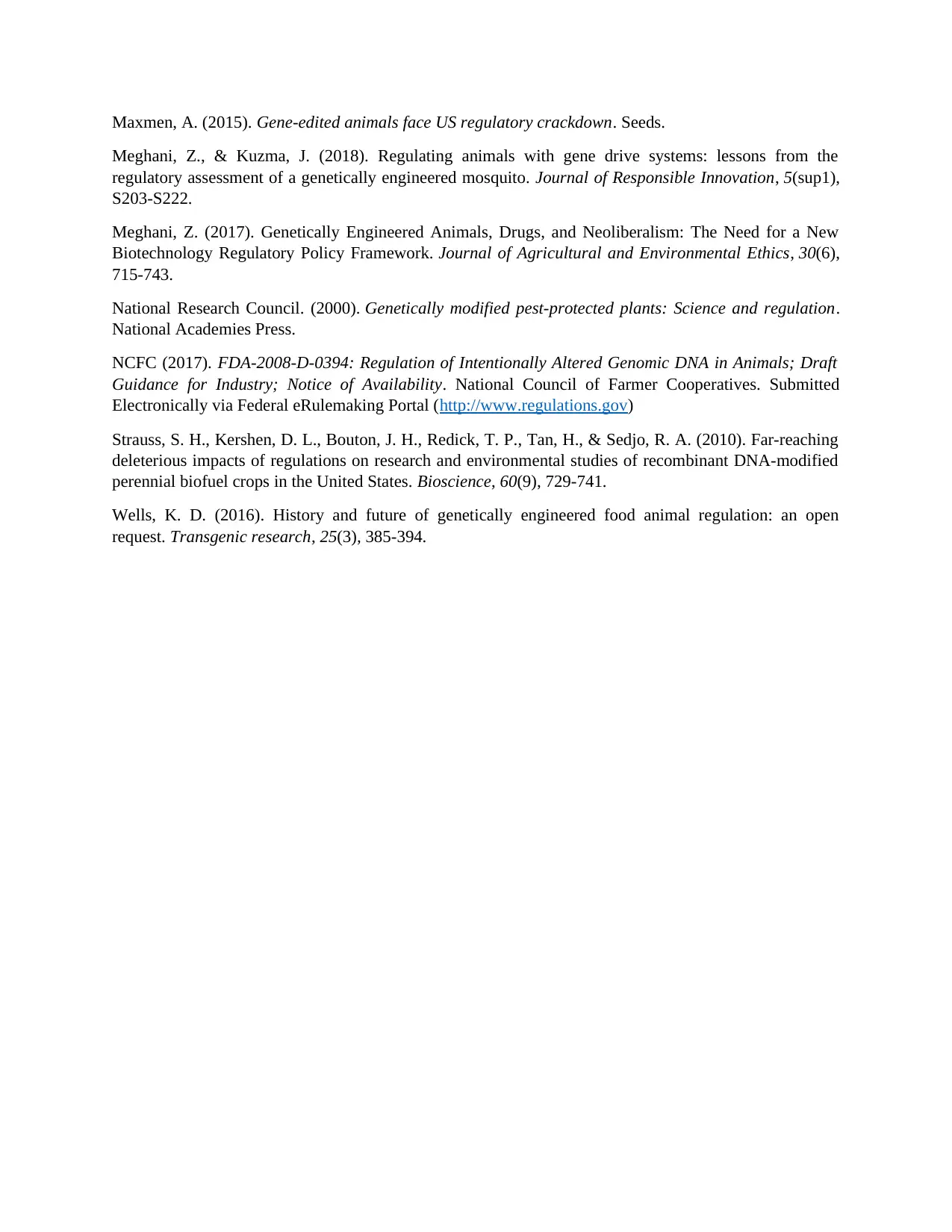
Maxmen, A. (2015). Gene-edited animals face US regulatory crackdown. Seeds.
Meghani, Z., & Kuzma, J. (2018). Regulating animals with gene drive systems: lessons from the
regulatory assessment of a genetically engineered mosquito. Journal of Responsible Innovation, 5(sup1),
S203-S222.
Meghani, Z. (2017). Genetically Engineered Animals, Drugs, and Neoliberalism: The Need for a New
Biotechnology Regulatory Policy Framework. Journal of Agricultural and Environmental Ethics, 30(6),
715-743.
National Research Council. (2000). Genetically modified pest-protected plants: Science and regulation.
National Academies Press.
NCFC (2017). FDA-2008-D-0394: Regulation of Intentionally Altered Genomic DNA in Animals; Draft
Guidance for Industry; Notice of Availability. National Council of Farmer Cooperatives. Submitted
Electronically via Federal eRulemaking Portal (http://www.regulations.gov)
Strauss, S. H., Kershen, D. L., Bouton, J. H., Redick, T. P., Tan, H., & Sedjo, R. A. (2010). Far-reaching
deleterious impacts of regulations on research and environmental studies of recombinant DNA-modified
perennial biofuel crops in the United States. Bioscience, 60(9), 729-741.
Wells, K. D. (2016). History and future of genetically engineered food animal regulation: an open
request. Transgenic research, 25(3), 385-394.
Meghani, Z., & Kuzma, J. (2018). Regulating animals with gene drive systems: lessons from the
regulatory assessment of a genetically engineered mosquito. Journal of Responsible Innovation, 5(sup1),
S203-S222.
Meghani, Z. (2017). Genetically Engineered Animals, Drugs, and Neoliberalism: The Need for a New
Biotechnology Regulatory Policy Framework. Journal of Agricultural and Environmental Ethics, 30(6),
715-743.
National Research Council. (2000). Genetically modified pest-protected plants: Science and regulation.
National Academies Press.
NCFC (2017). FDA-2008-D-0394: Regulation of Intentionally Altered Genomic DNA in Animals; Draft
Guidance for Industry; Notice of Availability. National Council of Farmer Cooperatives. Submitted
Electronically via Federal eRulemaking Portal (http://www.regulations.gov)
Strauss, S. H., Kershen, D. L., Bouton, J. H., Redick, T. P., Tan, H., & Sedjo, R. A. (2010). Far-reaching
deleterious impacts of regulations on research and environmental studies of recombinant DNA-modified
perennial biofuel crops in the United States. Bioscience, 60(9), 729-741.
Wells, K. D. (2016). History and future of genetically engineered food animal regulation: an open
request. Transgenic research, 25(3), 385-394.
1 out of 7
Your All-in-One AI-Powered Toolkit for Academic Success.
+13062052269
info@desklib.com
Available 24*7 on WhatsApp / Email
![[object Object]](/_next/static/media/star-bottom.7253800d.svg)
Unlock your academic potential
© 2024 | Zucol Services PVT LTD | All rights reserved.
